- Kenmore refrigerator water filters
- Whirlpool refrigerator water filters
- Samsung refrigerator water filters
- GE refrigerator water filters
- LG refrigerator water filters
- Frigidaire refrigerator water filters
- KitchenAid refrigerator water filters
- Maytag refrigerator water filters
- Kenmore Elite refrigerator water filters
- Estate refrigerator water filters
- GE Profile refrigerator water filters
- Amana refrigerator water filters
- Bosch refrigerator water filters
- Dacor refrigerator water filters
- Electrolux refrigerator water filters
Gas Leaf Blower: Why won't my leaf blower start?
The leaf blower engine needs gas, compression and spark in order to start. First, make sure there's fresh gas in the tank-old gas accumulates water and burns poorly. Replace the fuel if it's old. Add fuel stabilizer to the gas when you refill the tank to help keep the fuel fresh.
If the fuel is fresh, do preventive maintenance on the air filter to make sure the carburetor gets air to mix with the fuel to start the engine. Follow the instructions for in your owner's manual for cleaning and maintaining the air filter. You'll need to lightly coat the air filter with oil on some leaf blower models so the right amount of clean air will enter the carburetor.
If the air filter is okay, check the fuel lines for cracks. Air enters the carburetor instead of fuel when fuel lines have cracks. Although the carburetor needs air through the filter, the carburetor doesn't need air flowing through the fuel lines. Replace the fuel lines if you find cracks in the lines.
If the fuel lines are okay but fuel doesn't move through the lines when you press the primer bulb, the fuel filter may be clogged. Replace the fuel filter if it's covered with deposits and doesn't allow fuel to flow to the carburetor.
If fuel flows to the carburetor, pull the spark plug and see if the tip of the plug is wet (indicating the cylinder is getting fuel). If the cylinder isn't getting fuel because of a clogged carburetor jet, rebuild or replace the carburetor.
If you see deposits or corrosion on the spark plug electrode when you pull it out, replace the spark plug.
Finally, to check for compression, remove the spark plug, press your thumb over the opening and pull the starter cord. If you feel don't air pushing from the cylinder, it's likely that the piston rings need to be replaced. (For an accurate compression reading, use a compression gauge.)
A damaged recoil starter can also prevent you from starting the leaf blower engine. If you can't pull the recoil starter rope, check the recoil starter and replace it if damaged.

THESE REPAIRS MAY HELP SOLVE YOUR GAS LEAF BLOWER PROBLEM
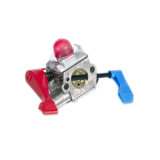
Replace the leaf blower carburetor
The leaf blower's carburetor mixes air and gasoline in the proper proportions to create a combustible gas. If the engine starts and then sputters, or doesn't start at all due to lack of fuel, you might need to replace carburetor. It's often more cost effective and practical to replace the carburetor rather than rebuild it.
Leaf blower carburetor
Find the required part specific to your product.
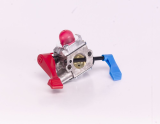
How to replace a leaf blower carburetor
Is your leaf blower not starting even though there's gas in the tank? It could be a problem with the carburetor. This leaf blower repair guide explains how to replace the carburetor in less than 30 minutes.
Repair difficulty
Time required
15 minutes or less
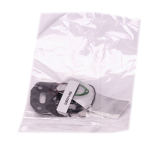
Rebuild the leaf blower carburetor
The leaf blower carburetor mixes air and gasoline in the proper proportions to create a combustible gas. If the engine starts and then sputters, or doesn't start at all due to lack of fuel, you can rebuild the carburetor. Rebuild kits are available for most carburetors and contain essential components for rebuilding a leaf blower carburetor, such as diaphragms, seals and gaskets. You can sometimes fix a fuel supply problem by dismantling and cleaning a carburetor. Use the kit to rebuild the carburetor after cleaning it.
Rebuild the leaf blower carburetor
Find the required part specific to your product.
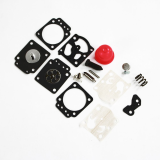
How to rebuild a leaf blower carburetor
When a leaf blower won't start even when there's gas in the fuel tank, the problem could be the carburetor. The step-by-step repair guide explains how to rebuild a leaf blower carburetor.
Repair difficulty
Time required
60 minutes or less
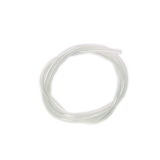
Replace the leaf blower fuel lines
A leaf blower's fuel lines carry fuel from the tank to the carburetor and from the primer bulb to the fuel system. Fuel lines become brittle over time and can crack or break. Replace a fuel line that's brittle or damaged. Be careful to install new fuel lines on the engine the same way the original fuel lines were configured.
Leaf blower fuel lines
Find the required part specific to your product.
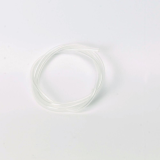
How to replace leaf blower fuel lines
If your leaf blower won't start, it could be that a clogged or cracked fuel line isn't letting gas into the carburetor. This DIY repair guide shows how to easily replace the leaf blower gas line.
Repair difficulty
Time required
60 minutes or less
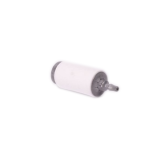
Replace the leaf blower fuel filter
The fuel filter is located at the end of the fuel line inside the gas tank. It filters dirt and other particles from the fuel as gasoline moves from the fuel tank to the carburetor. Replace the filter when it becomes dirty and clogged.
Leaf blower fuel filter
Find the required part specific to your product.

How to replace leaf blower fuel lines
If your leaf blower won't start, it could be that a clogged or cracked fuel line isn't letting gas into the carburetor. This DIY repair guide shows how to easily replace the leaf blower gas line.
Repair difficulty
Time required
60 minutes or less

Do leaf blower preventive maintenance
Proper maintenance ensures that your leaf blower runs smoothly and works properly. Refer to your owner's manual for guidance in maintaining the leaf blower. Replace parts such as the air filter, fuel filter and spark plug.
Do leaf blower preventive maintenance
Find the required part specific to your product.

Replace the leaf blower recoil starter
The leaf blower's recoil starter consists of a rope and spring-loaded pulley system. If the pull rope doesn't retract, it's likely that the spring inside the recoil starter is broken. The recoil starter can also fail to engage the engine when the rope is pulled. Replace the recoil starter if the spring breaks or if the recoil starter won't engage the engine.
Leaf blower recoil starter
Find the required part specific to your product.
Symptoms for gas leaf blowers
Choose a symptom to see related leaf blower repairs.
Main causes: cracked fuel lines, leaky carburetor seals, damaged fuel tank cap, cracked fuel tank…
Main causes: damaged fan blade, engine needs a tune up, dirty carburetor…
Main causes: stale fuel, dirty air filter, bad spark plug, cracked fuel lines, clogged carburetor…
Main causes: mixing too much 2-cycle oil with the gas, dirty air filter, clogged carburetor, engine needs tune up…
Main causes: bad gas, clogged air filter, cracked fuel lines, clogged fuel filter, dirty carburetor, bad spark plug, wor…
Repair guides for gas leaf blowers
These step-by-step repair guides will help you safely fix what’s broken on your leaf blower.

How to replace a leaf blower carburetor
The carburetor could be the problem If the leaf blower engine won't start even though there's fuel in the tank. Follow t…
Repair difficulty
Time required
15 minutes or less

How to replace leaf blower fuel lines
Leaf blower fuel lines deteriorate with time and eventually can split or crack. You can remove and replace them yourself…
Repair difficulty
Time required
60 minutes or less

How to rebuild a leaf blower carburetor
If the leaf blower engine won't start even though there's fuel in the tank, the carburetor could be the problem. Follow …
Repair difficulty
Time required
60 minutes or less
Articles and videos for gas leaf blowers
Use the advice and tips in these articles to get the most out of your leaf blower.
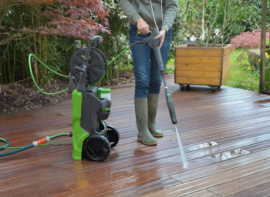
Learn about the top 10 must-have electric lawn & garden tools for 2023…
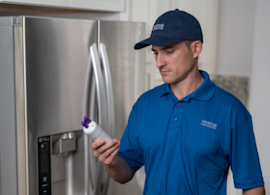
Get answers to frequently asked questions about Sears and Sears PartsDirect.…
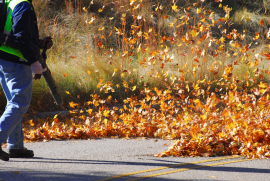
Follow this advice for caring for your leaf blower.…